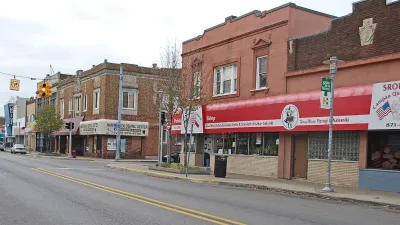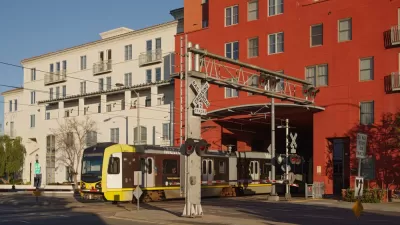Six years ago, the 620-square-mile city had not one bike lane and forty McDonald's franchises.
When Oklahoma City mayor Mick Cornett read that his hometown topped a list of America's fattest cities, he challenged himself and the city to collectively lose one million pounds.
"I was seeing how we had designed the city around the automobile. No one walked anywhere—we didn’t have sidewalks to any great extent in the suburbs," Cornett told Men's Fitness. "Our inner city grade schools didn’t even have gymnasiums. That was the culture that we had created for ourselves."
The mayor hired Jeff Speck to advise him on what could be done. Speck determined that the city had twice as many car lanes as it needed. Further, the one-way system of highways encouraged high speeds and severely impacted walkability. The mayor recognized that the city's health problems were directly related to the walkability problem.
In addition to building a convention center and other capital improvement projects, MAPS 3, as it is called, would pay to address the city's obesity epidemic by building bike lanes, sidewalks and health and wellness facilities as well as a downtown public transit system. Instead of a soda tax, which would have been politically unpopular in such a conservative town, the citizens of Oklahoma City agreed to finance the project partially through the extension of an expiring sales tax program for a period of seven years.
"The experiment is unusual in terms of its ambition, breadth and cost, all of which take it beyond anything being attempted by other American cities in the fight against fat," reports Ian Birell.
The city reached is goal of losing one million pounds, and the mayor shed nearly forty himself. The once-dilapidated downtown district went from having one hotel to fifteen.
However, Birrell is cautiously optimistic. "Yet the key question is whether even such valiant and wide-ranging efforts can dent such a huge health problem, one needlessly killing so many people on the planet."
FULL STORY: The Fat City That Declared War On Obesity

Study: Maui’s Plan to Convert Vacation Rentals to Long-Term Housing Could Cause Nearly $1 Billion Economic Loss
The plan would reduce visitor accommodation by 25,% resulting in 1,900 jobs lost.

North Texas Transit Leaders Tout Benefits of TOD for Growing Region
At a summit focused on transit-oriented development, policymakers discussed how North Texas’ expanded light rail system can serve as a tool for economic growth.

Why Should We Subsidize Public Transportation?
Many public transit agencies face financial stress due to rising costs, declining fare revenue, and declining subsidies. Transit advocates must provide a strong business case for increasing public transit funding.

How Community Science Connects People, Parks, and Biodiversity
Community science engages people of all backgrounds in documenting local biodiversity, strengthening connections to nature, and contributing to global efforts like the City Nature Challenge to build a more inclusive and resilient future.

Alabama: Trump Terminates Settlements for Black Communities Harmed By Raw Sewage
Trump deemed the landmark civil rights agreement “illegal DEI and environmental justice policy.”

Dear Tesla Driver: “It’s not You, It’s Him.”
Amidst a booming bumper sticker industry, one writer offers solace to those asking, “Does this car make me look fascist?”
Urban Design for Planners 1: Software Tools
This six-course series explores essential urban design concepts using open source software and equips planners with the tools they need to participate fully in the urban design process.
Planning for Universal Design
Learn the tools for implementing Universal Design in planning regulations.
City of Santa Clarita
Ascent Environmental
Institute for Housing and Urban Development Studies (IHS)
City of Grandview
Harvard GSD Executive Education
Toledo-Lucas County Plan Commissions
Salt Lake City
NYU Wagner Graduate School of Public Service




























